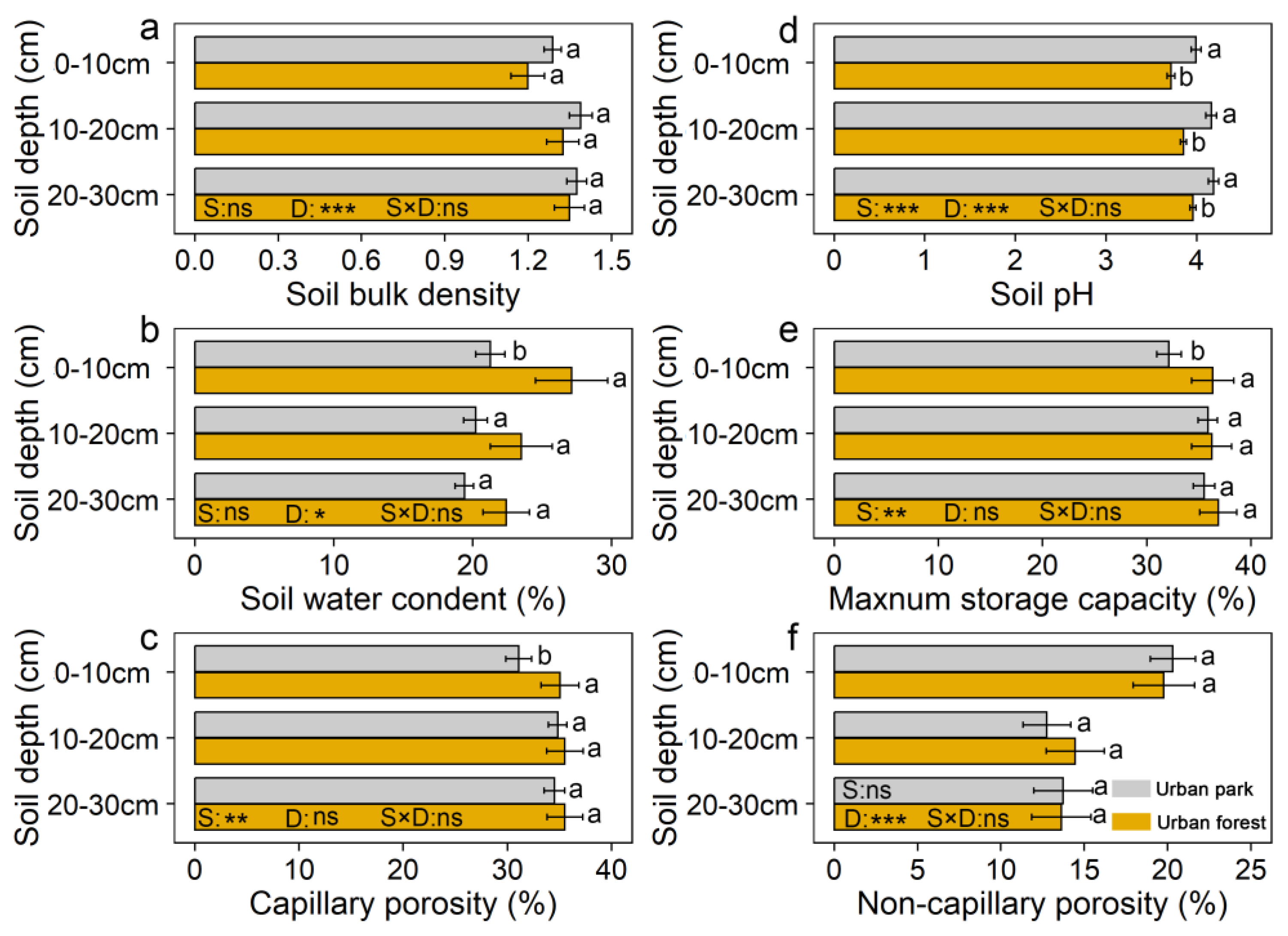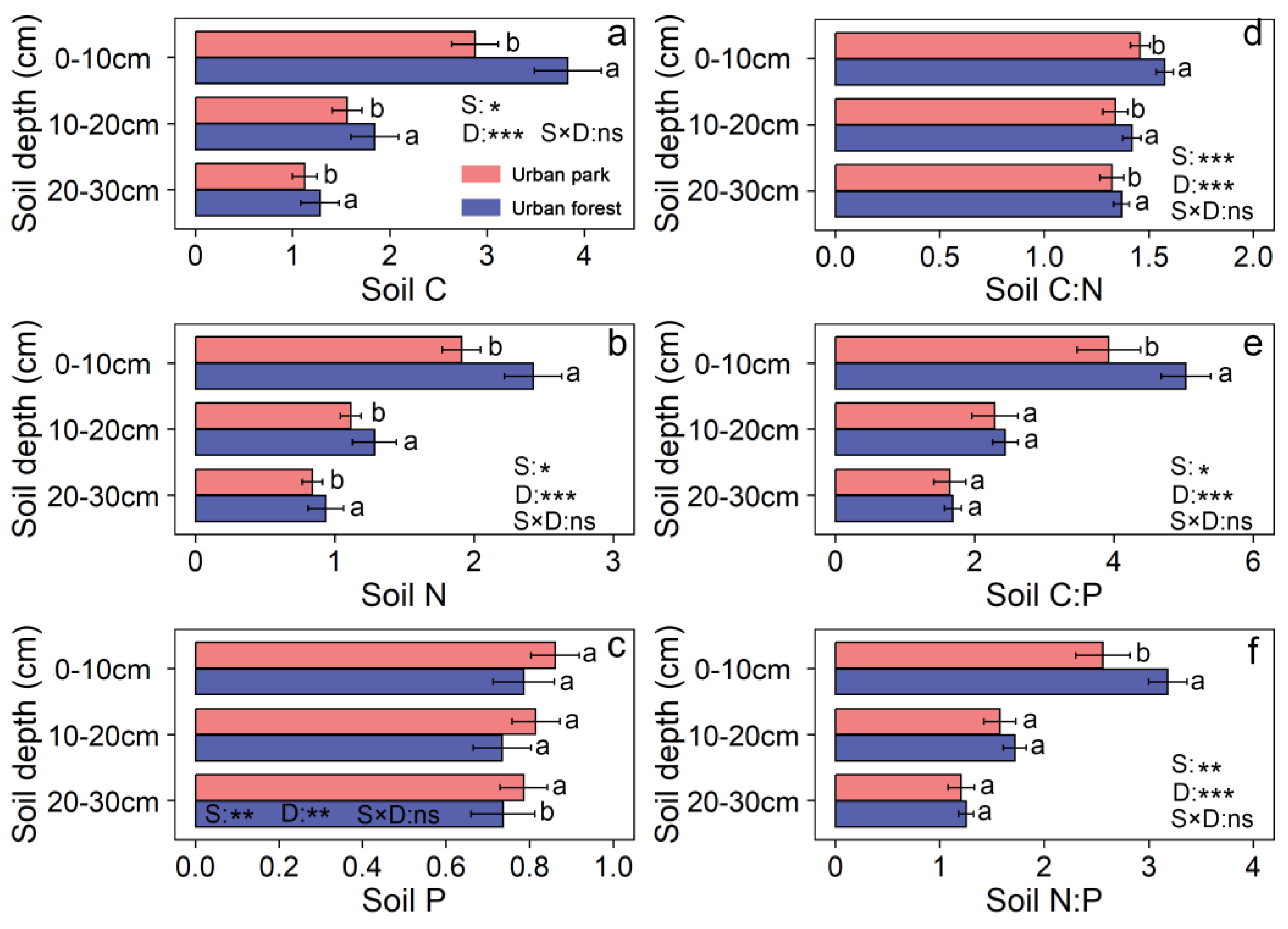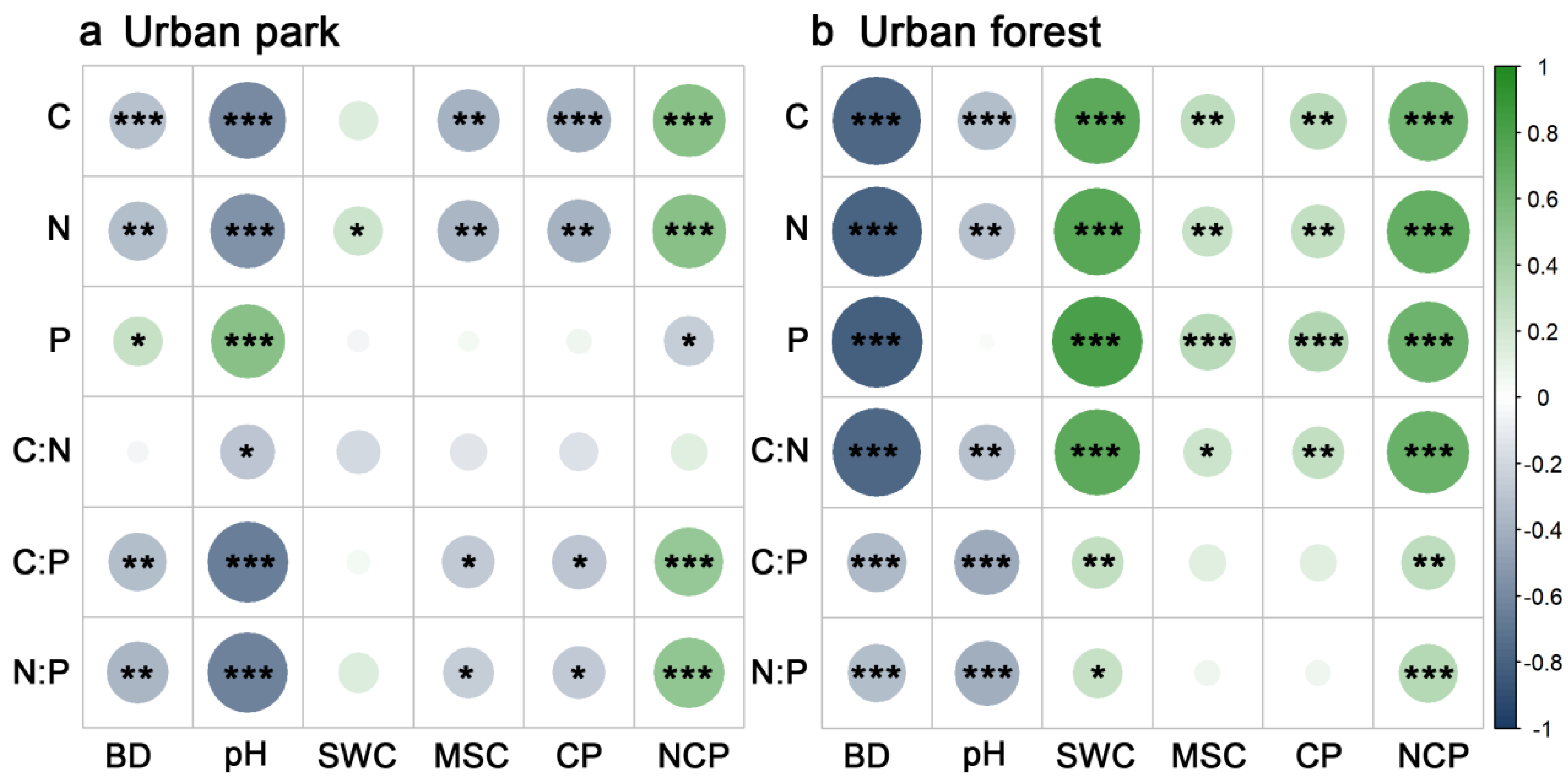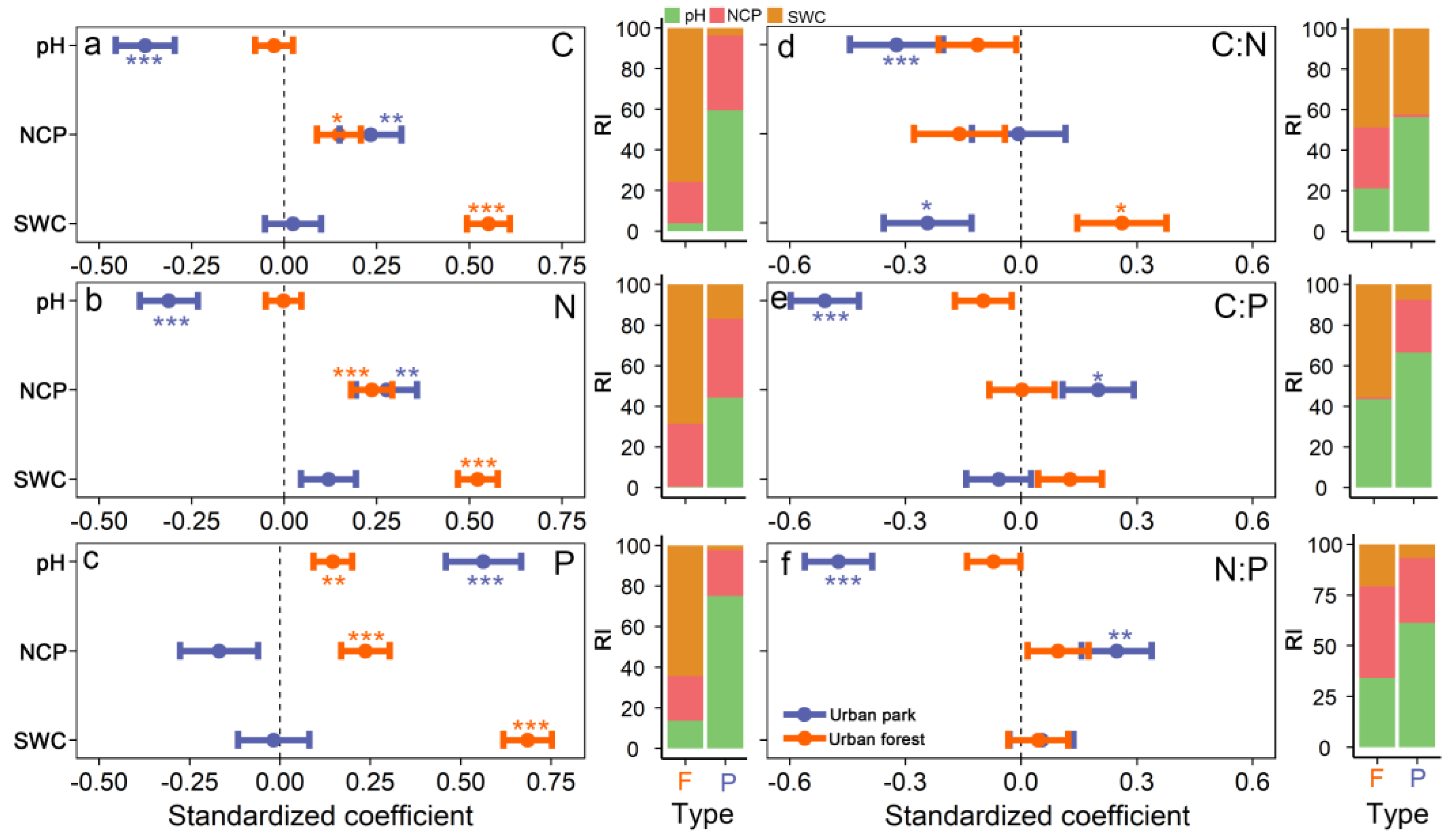Soil C:N:P Stoichiometry in Two Contrasting Urban Forests in the Guangzhou Metropolis: Differences and Related Dominates
Abstract
1. Introduction
2. Materials and Methods
2.1. Study Site
2.2. Soil Sampling and Measurement
2.3. Statistical Analyses
3. Results
3.1. Changes in Soil Physicochemical Properties of Two Urban Forests
3.2. Changes in Soil C, N, and P Contents and Stoichiometry of Two Urban Forests
3.3. Relationships Between Soil Properties and C, N, and P Contents and Stoichiometry in Two Urban Forests
3.4. Key Determinants of Soil C, N, and P Contents and Stoichiometry in Two Urban Forests
4. Discussion
4.1. Differences in Soil Properties and C, N, and P Contents and Stoichiometry in Two Urban Forests
4.2. Key Determinants of Soil C, N, and P Contents and Stoichiometry Under Two Urban Forests
5. Conclusions
Author Contributions
Funding
Data Availability Statement
Conflicts of Interest
References
- Elser, J.J.; Sterner, R.W.; Gorokhova, E.; Fagan, W.F.; Markow, T.A.; Cotner, J.B.; Harrison, J.F.; Hobbie, S.E.; Odell, G.M.; Weider, L.W. Biological stoichiometry from genes to ecosystems. Ecol. Lett. 2000, 3, 540–550. [Google Scholar] [CrossRef]
- Yang, Y.; Luo, Y. Carbon: Nitrogen stoichiometry in forest ecosystems during stand development. Glob. Ecol. Biogeogr. 2011, 20, 354–361. [Google Scholar] [CrossRef]
- Reich, P.B.; Hungate, B.A.; Luo, Y. Carbon-nitrogen interactions in terrestrial ecosystems in response to rising atmospheric carbon dioxide. Annu. Rev. Ecol. Evol. Syst. 2006, 37, 611–636. [Google Scholar] [CrossRef]
- Michaels, A.F. The ratios of life. Science 2003, 300, 906–907. [Google Scholar] [CrossRef]
- Zuo, X.A.; Zhao, X.Y.; Zhao, H.L.; Zhang, T.; Guo, Y.; Li, Y.; Huang, Y. Spatial heterogeneity of soil properties and vegetation-soil relationships following vegetation restoration of mobile dunes in Horqin Sandy Land, Northern China. Plant Soil 2009, 318, 153–167. [Google Scholar] [CrossRef]
- Fu, X.L.; Shao, M.G.; Wei, X.R.; Horton, R. Soil organic carbon and total nitrogen as affected by vegetation types in Northern Loess Plateau of China. Geoderma 2010, 155, 31–35. [Google Scholar] [CrossRef]
- Achat, D.L.; Augusto, L.; Gallet-Budynek, A.; Loustau, D. Future challenges in coupled C-N-P cycle models for terrestrial ecosystems under global change: A review. Biogeochemistry 2016, 131, 173–202. [Google Scholar] [CrossRef]
- Zhang, S.; Deng, Q.; Wang, Y.P.; Chen, J.; Yu, M.; Fang, X.; He, H.; Chen, J.; Xu, P.; Wang, S.; et al. Linkage of microbial living communities and residues to soil organic carbon accumulation along a forest restoration gradient in southern China. For. Ecosyst. 2021, 8, 57. [Google Scholar] [CrossRef]
- Chen, X.; Chen, H.Y.H. Plant mixture balances terrestrial ecosystem C: N: P stoichiometry. Nat. Commun. 2021, 12, 4562. [Google Scholar] [CrossRef]
- Elser, J.J.; Fagan, W.F.; Kerkhoff, A.J.; Swenson, N.G.; Enquist, B.J. Biological stoichiometry of plant production: Metabolism, scaling and ecological response to global change. New Phytol. 2010, 186, 593–608. [Google Scholar] [CrossRef] [PubMed]
- Tian, H.; Chen, G.; Zhang, C.; Melillo, J.M.; Hall, C.A.S. Pattern and variation of C: N: P ratios in China’s soils: A synthesis of observational data. Biogeochemistry 2010, 98, 139–151. [Google Scholar] [CrossRef]
- Zechmeister-Boltenstern, S.; Keiblinger, K.M.; Mooshammer, M.; Peñuelas, J.; Richter, A.; Sardans, J.; Wanek, W. The application of ecological stoichiometry to plant–microbial–soil organic matter transformations. Ecol. Monogr. 2015, 85, 133–155. [Google Scholar] [CrossRef]
- Li, Y.; Wu, J.; Liu, S.; Shen, J.; Huang, D.; Su, Y.; Wei, W.; Syers, J.K. Is the C: N: P stoichiometry in soil and soil microbial biomass related to the landscape and land use in southern subtropical China? Glob. Biogeochem. Cycles 2012, 26, GB004399. [Google Scholar] [CrossRef]
- Fan, H.; Wu, J.; Liu, W.; Yuan, Y.; Hu, L.; Cai, Q. Linkages of plant and soil C: N: P stoichiometry and their relationships to forest growth in subtropical plantations. Plant Soil 2015, 392, 127–138. [Google Scholar] [CrossRef]
- Tang, X.; Hu, J.; Lu, Y.; Qiu, J.; Dong, Y.; Li, B. Soil C, N, P stocks and stoichiometry as related to land use types and erosion conditions in lateritic red soil region, south China. Catena 2022, 210, 105888. [Google Scholar] [CrossRef]
- Ding, W.; Gao, H.; Qi, Z.; Sun, L.; Zheng, C.; Huang, J.; Filipović, V.; He, H. Enhancing soil ecological stoichiometry and orchard yield through ground cover management: A meta-analysis across China. Agric. Ecosyst. Environ. 2025, 384, 109556. [Google Scholar] [CrossRef]
- Huo, C.; Zhang, Z.; Luo, Y.; Hu, G. Altitudinal patterns of soil and microbial C: N: P stoichiometry in subtropical forests in Daming Mountain, South China. Front. Earth Sci. 2025, 13, 1569387. [Google Scholar] [CrossRef]
- Montagnini, F.; Ramstad, K.; Sancho, F. Litterfall, litter decomposition and the use of mulch of four indigenous tree species in the Atlantic lowlands of Costa Rica. Agrofor. Syst. 1993, 23, 39–61. [Google Scholar] [CrossRef]
- Warren, M.W.; Zou, X. Soil macrofauna and litter nutrients in three tropical tree plantations on a disturbed site in Puerto Rico. For. Ecol. Manag. 2002, 170, 161–171. [Google Scholar] [CrossRef]
- Hobbie, S.E.; Reich, P.B.; Oleksyn, J.; Ogdahl, M.; Zytkowiak, R.; Hale, C.; Karolewski, P. Tree species effects on decomposition and forest floor dynamics in a common garden. Ecology 2006, 87, 2288–2297. [Google Scholar] [CrossRef]
- Sardans, J.; Rivas-Ubach, A.; Peñuelas, J. The C: N: P stoichiometry of organisms and ecosystems in a changing world: A review and perspectives. Perspect. Plant Ecol. Evol. Syst. 2012, 14, 33–47. [Google Scholar] [CrossRef]
- Wang, T.; Chen, X.; Zhao, X.; Sardans, J.; Peñuelas, J.; Da, M.; Fu, Y.; Yu, Z.; Wan, X.; Shi, X.; et al. Tree mycorrhizal type mediates the responses of foliar stoichiometry and tree growth to functionally dissimilar neighbours in a subtropical forest experiment. Funct. Ecol. 2024, 38, 765–777. [Google Scholar] [CrossRef]
- Sartori, F.; Lal, R.; Ebinger, M.H.; Eaton, J.A. Changes in soil carbon and nutrient pools along a chronosequence of poplar plantations in the Columbia Plateau, Oregon, USA. Agric. Ecosyst. Environ. 2007, 122, 325–339. [Google Scholar] [CrossRef]
- Sartori, F.; Markewitz, D.; Borders, B.E. Soil carbon storage and nitrogen and phosphorous availability in loblolly pine plantations over 4 to16 years of herbicide and fertilizer treatments. Biogeochemistry 2007, 84, 13–30. [Google Scholar] [CrossRef]
- Ouyang, S.; Xiang, W.; Wang, X.; Xiao, W.; Chen, L.; Li, S.; Sun, H.; Deng, X.; Forrester, D.I.; Zeng, L.; et al. Effects of stand age, richness and density on productivity in subtropical forests in China. J. Ecol. 2019, 107, 2266–2277. [Google Scholar] [CrossRef]
- Fox, J.; Monette, G. Generalized collinearity diagnostics. J. Am. Stat. Assoc. 1992, 87, 178–183. [Google Scholar] [CrossRef]
- Zuur, A.F.; Ieno, E.N.; Walker, N.J.; Saveliev, A.A.; Smith, G.M. Mixed Effects Models and Extensions in Ecology with R; Springer: New York, NY, USA, 2009. [Google Scholar]
- R Core Team. R: A Language and Environment for Statistical Computing (v. 3.5.3); R Foundation for Statistical Computing: Vienna, Austria, 2019; Available online: https://www.R-project.org/ (accessed on 11 March 2019).
- Hume, A.; Chen, H.Y.H.; Taylor, A.R.; Kayahara, G.J.; Man, R. Soil C:N:P dynamics during secondary succession following fire in the boreal forest of central Canada. For. Ecol. Manag. 2016, 369, 1–9. [Google Scholar] [CrossRef]
- Shi, J.; Deng, L.; Wu, J.; Bai, E.; Chen, J.; Shangguan, Z.; Kuzyakov, Y. Soil organic carbon increases with decreasing microbial carbon use efficiency during vegetation restoration. Glob. Change Biol. 2024, 30, e17616. [Google Scholar] [CrossRef]
- Zhao, Z.; Qin, Y.; Wu, Y.; Chen, W.; Wang, H.; Chen, J.; Yang, J.; Liu, G.; Xue, S. Microbial necromass carbon drives soil organic carbon accumulation during long-term vegetation succession. J. Appl. Ecol. 2025, 62, 932–944. [Google Scholar] [CrossRef]
- Chen, G.; Yuan, J.; Wang, S.; Liang, Y.; Wang, D.; Zhu, Y.; Wang, Y. Soil and microbial C:N:P stoichiometries play vital roles in regulating P transformation in agricultural ecosystems: A review. Pedosphere 2024, 34, 44–51. [Google Scholar] [CrossRef]
- Sokol, N.W.; Kuebbing, S.E.; Karlsen-Ayala, E.; Bradford, M.A. Evidence for the primacy of living root inputs, not root or shoot litter, in forming soil organic carbon. New Phytol. 2019, 221, 233–246. [Google Scholar] [CrossRef]
- Liang, G.; Stark, J.; Waring, B.G. Mineral reactivity determines root effects on soil organic carbon. Nat. Commun. 2023, 14, 4962. [Google Scholar] [CrossRef]
- Yao, X.; Hui, D.; Xing, S.; Zhang, Q.; Chen, J.; Li, Z.; Xu, Y.; Deng, Q. Mixed plantations with N-fixing tree species maintain ecosystem C:N:P stoichiometry: Implication for sustainable production. Soil Biol. Biochem. 2024, 191, 109356. [Google Scholar] [CrossRef]
- Cotrufo, M.F.; Wallenstein, M.D.; Boot, C.M.; Denef, K.; Paul, E. The microbial efficiency-matrix stabilization (MEMS) framework integrates plant litter decomposition with soil organic matter stabilization: Do labile plant inputs form stable soil organic matter? Glob. Change Biol. 2013, 19, 988–995. [Google Scholar] [CrossRef] [PubMed]
- Lange, M.; Eisenhauer, N.; Sierra, C.A.; Bessler, H.; Engels, C.; Griffiths, R.I.; Mellado-Vázquez, P.G.; Malik, A.A.; Roy, J.; Scheu, S.; et al. Plant diversity increases soil microbial activity and soil carbon storage. Nat. Commun. 2015, 6, 6707. [Google Scholar] [CrossRef] [PubMed]
- Xue, L.; Ren, H.; Li, S.; Leng, X.; Yao, X. Soil bacterial community structure and co-occurrence pattern during vegetation restoration in karst rocky desertification area. Front. Microbiol. 2017, 8, 2377. [Google Scholar] [CrossRef] [PubMed]
- Zhou, G.Y.; Xu, S.; Ciais, P.; Manzoni, S.; Fang, J.; Yu, G.; Tang, X.; Zhou, P.; Wang, W.; Yan, J.; et al. Climate and litter C/N ratio constrain soil organic carbon accumulation. Natl. Sci. Rev. 2019, 6, 746–757. [Google Scholar] [CrossRef]
- Geng, Q.; Ma, X.; Peng, F.; Zhu, Z.; Li, Q.; Xu, D.; Ruan, H.; Xu, X. Consistent responses of the C:N:P stoichiometry of green leaves and fine roots to N addition in poplar plantations in eastern coastal China. Plant Soil 2023, 485, 377–394. [Google Scholar] [CrossRef]
- Walker, T.W.; Syers, J.K. The fate of phosphorus during pedogenesis. Geoderma 1976, 15, 1–19. [Google Scholar] [CrossRef]
- Adams, R.N. Carbon paste electrodes. Anal. Chem. 1958, 30, 1576. [Google Scholar] [CrossRef]
- Sá, J.C.D.M.; Lal, R. Stratification ratio of soil organic matter pools as an indicator of carbon sequestration in a tillage chronosequence on a Brazilian Oxisol. Soil Tillage Res. 2009, 103, 46–56. [Google Scholar] [CrossRef]
- Hu, B.; Xie, M.; Li, H.; Zhao, W.; Hu, J.; Jiang, Y.; Ji, W.; Li, S.; Hong, Y.; Yang, M.; et al. Stoichiometry of soil carbon, nitrogen, and phosphorus in farmland soils in southern China: Spatial pattern and related dominates. Catena 2022, 217, 106468. [Google Scholar] [CrossRef]
- Wang, L.; Zhang, G.; Zhu, P.; Xing, S.; Wang, C. Soil C, N and P contents and their stoichiometry as affected by typical plant communities on steep gully slopes of the Loess Plateau, China. Catena 2022, 208, 105740. [Google Scholar] [CrossRef]
- Helalia, A.M. The relation between soil infiltration and effective porosity in different soils. Agric. Water Manag. 1993, 24, 39–47. [Google Scholar] [CrossRef]
- Yu, B.; Xie, C.; Cai, S.; Chen, Y.; Lv, Y.; Mo, Z.; Liu, T.; Yang, Z. Effects of tree root density on soil total porosity and non-capillary porosity using a ground-penetrating tree radar unit in Shanghai, China. Sustainability 2018, 10, 4640. [Google Scholar] [CrossRef]
- Allais, L.; Thibodeau, B.; Khan, N.S.; Crowe, S.A.; Cannicci, S.; Not, C. Salinity, mineralogy, porosity, and hydrodynamics as drivers of carbon burial in urban mangroves from a megacity. Sci. Total Environ. 2024, 912, 168955. [Google Scholar] [CrossRef] [PubMed]
- Vasileva, V.; Ilieva, A. Root biomass accumulation and nitrogen in roots of pea (Pisum sativum L.) after treatment with organic fertilizer. Glob. J. Adv. Biol. Sci. 2015, 1, 1–4. [Google Scholar]
- Vergani, C.; Graf, F. Soil permeability, aggregate stability and root growth: A pot experiment from a soil bioengineering perspective. Ecohydrology 2016, 9, 830–842. [Google Scholar] [CrossRef]
- Jia, Z.; Weng, B.; Yan, D.; Jia, Z.; Weng, B.; Yan, D.; Peng, H.; Dong, Z. The effects of different factors on soil water infiltration properties in High Mountain Asia: A meta-analysis. Catena 2024, 234, 107583. [Google Scholar] [CrossRef]





Disclaimer/Publisher’s Note: The statements, opinions and data contained in all publications are solely those of the individual author(s) and contributor(s) and not of MDPI and/or the editor(s). MDPI and/or the editor(s) disclaim responsibility for any injury to people or property resulting from any ideas, methods, instructions or products referred to in the content. |
© 2025 by the authors. Licensee MDPI, Basel, Switzerland. This article is an open access article distributed under the terms and conditions of the Creative Commons Attribution (CC BY) license (https://creativecommons.org/licenses/by/4.0/).
Share and Cite
Xiong, Y.; Li, Z.; Meng, S.; Xu, J. Soil C:N:P Stoichiometry in Two Contrasting Urban Forests in the Guangzhou Metropolis: Differences and Related Dominates. Forests 2025, 16, 1268. https://doi.org/10.3390/f16081268
Xiong Y, Li Z, Meng S, Xu J. Soil C:N:P Stoichiometry in Two Contrasting Urban Forests in the Guangzhou Metropolis: Differences and Related Dominates. Forests. 2025; 16(8):1268. https://doi.org/10.3390/f16081268
Chicago/Turabian StyleXiong, Yongmei, Zhiqi Li, Shiyuan Meng, and Jianmin Xu. 2025. "Soil C:N:P Stoichiometry in Two Contrasting Urban Forests in the Guangzhou Metropolis: Differences and Related Dominates" Forests 16, no. 8: 1268. https://doi.org/10.3390/f16081268
APA StyleXiong, Y., Li, Z., Meng, S., & Xu, J. (2025). Soil C:N:P Stoichiometry in Two Contrasting Urban Forests in the Guangzhou Metropolis: Differences and Related Dominates. Forests, 16(8), 1268. https://doi.org/10.3390/f16081268




